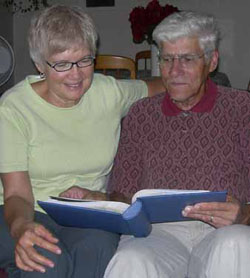Canadian Mennonite
Volume 12, No. 19
Sept. 29, 2008
The world in their home
What happens when family lines cross cultural boundaries?
Winnipeg
 |
Parenting is hard work. Martin and Maria Penner, now members of Sargent Avenue Mennonite Church in Winnipeg, knew this, and when they realized that a “homemade” child was not possible for them, they knew they still wanted to take on the parenting challenge. So the Penners literally brought the world into their home and family by adopting three children from three different racial backgrounds.
Martin and Maria were married 37 years ago. He had finished his studies in agriculture and she in nursing when they applied for voluntary service positions in Recife, Brazil, with Mennonite Central Committee (MCC) in 1973.
As they began the adoption process in Brazil, their only stipulation was that the child be a healthy baby, although a Brazilian midwife instructed them to adopt a white child. In Brazil, the intermingling of African, Dutch, indigenous peoples and other races has created a wide diversity of skin and hair colouring.
“For them it was a real issue,” says Maria.
They adopted Tim, “who had olive skin, like I,” says Martin, adding, “He would have passed as a ‘homemade’ child. That’s how they would have done it in that culture.”
When Tim was two, the Penners began to pray about adopting another child.
A week later, a call came from co-workers with MCC in Yalve Sanga, Paraguay, where the Penners were now serving. (In this area of Paraguay, there was a high percentage of multiple births among the aboriginals, who considered twins an evil omen and often practised infanticide. With the coming of Mennonites, the families were encouraged to give one of the twins up for adoption.) This was the third set of twins in this family; the mother had taken both babies home, but soon she wanted to give up her daughter. So Cheryl was added to the Penner family.
“We now had a racially mixed family when we returned in 1979 to Canada,” says Maria. “We put in a request to adopt here. Race and gender were not factors for us, but we wanted a newborn. Within six months, we adopted a mixed Caucasian-Jamaican boy” named Stefan.
“This is not something we did as a mission,” Martin points out. “We needed and wanted a family. We had a need, the child had a need, the biological parents had a need. All the needs were met,” he says, pointing out that they always stressed to their children that their parents gave them up for adoption as acts of love—not abandonment.
Before moving to Winnipeg, the family lived in rural Manitoba.
“Our first concern was how the immediate family would accept this, then our church community, and lastly how society and the school system would deal with this,” says Martin. “The relationships within the church were about what we expected,” he says. “We had the sense our kids were accepted not because of who they are, but whose they are.”
Tim died in an accident in 1993.
Cheryl, who is now married and lives and works in rural Manitoba, was always treated as a North American Indian. The Penners recall when she was attending a Christian high school in Winnipeg, the topic of Aboriginal Peoples in Canada came up. “The kids in school talked very negatively . . . and she felt like she could have crawled under the floor,” says Martin. “We talked at length with her and the teacher. Next year, when this topic came up again, she said to the class, ‘Do you know how this makes me feel? This hurts me.’ Some of her classmates stood up with her. We are glad she gained that confidence. You need it when you are a minority.”
Stefan, their youngest, has been working for eight years at a job that has a culturally diverse staff.
“It has become his cultural family, which he wanted, rather than just a white Mennonite family,” Martin says. “In hindsight, we wish we could have worked at this more deliberately when he was younger, but settings that offered a greater cultural mix weren’t as available.”
The Penners can remember one of their children saying at five years of age, “It’s not fair that you’re white and you adopted us.” Martin acknowledges that such challenges have caused him to rethink “every detail of my faith that I had thought I had already worked through.”
Issues of racism continue to this day.
“We sense from our children that they don’t belong here, especially participating in the church,” Martin says. “It is not their home. We don’t have an answer except to be with them as they look for the answer.”